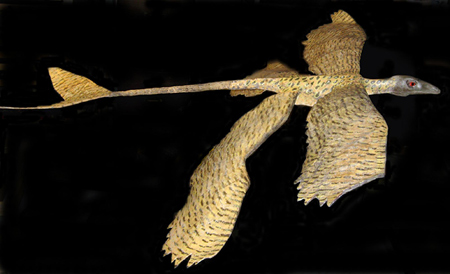Science Now:Birdlike Dinosaur Was Adept Glider
By Dennis Normile
ScienceNOW Daily News
25 January 2010
How did birds learn to fly? The first flight tests of a foam model of a four-winged, feathered dinosaur suggest that early birds may have started their aviation careers by gliding down from trees.
The fight over bird flight evolution is one of the longest-running and most heated debates in paleontology. Were the first flyers arboreal creatures that initially glided from tree tops to the ground? Or were they bipedal ground runners whose evolving wings allowed them to take progressively longer jumps? There is still no complete consensus.
In recent years, researchers have tried to determine the flight capabilities of early birds with mathematical analyses and computer simulations. And at least one group has built a physical model based on fossils and put it in a wind tunnel. Taking a different tack, biomechanics specialist David Alexander of the University of Kansas, Lawrence, along with colleagues there and at Northeastern University in Shenyang, China, reconstructed a specimen of Microraptor, a dinosaur notable for having four wings. Microraptor is a type of dromeosaur, a genus of birdlike dinosaurs.
The team made a skeleton, covered the "bones" with a clay "body," and added plumage made from modern pheasant feathers trimmed to match impressions preserved in fossils. The researchers used this feathered reconstruction to make urethane foam models that they launched from various heights, recording the distance, velocity, and angle of each glide. "Microraptor was an adept glider and would have had little difficulty gliding from tree trunk to tree trunk," the authors report today online in the Proceedings of the National Academy of Sciences.
Alexander, who says he was added to the team of paleontologists because of his knowledge of flying airplane models, says he doesn't know of any other groups that have tried to fly models of dinosaurs. This new approach is "probably one of the most effective" ways of determining the flight capabilities of extinct animals, says Zhonghe Zhou, a paleontologist at the Chinese Academy of Sciences' Institute of Vertebrate Paleontology and Paleoanthropology in Beijing. He expects similar experiments based on fossils of other animals could help clarify how avian flight originated.
Julia Clarke, a paleontologist at the University of Texas, Austin, agrees that models could be useful, but they have to be constrained by an understanding of anatomy. In the case of Microraptor, "I'm not convinced that in life the animal could have gotten into some of the postures that they are exploring," she says. She also thinks the community has moved beyond the dichotomy of trees-down or ground-up hypotheses, focusing on a more nuanced set of questions such as what anatomical evolutions enabled powered flight.

On the wing. A foam model of a four-winged dinosaur show how it could have glided among the trees. Credit: David Alexander et al., PNAS Early Edition
Download attachments: